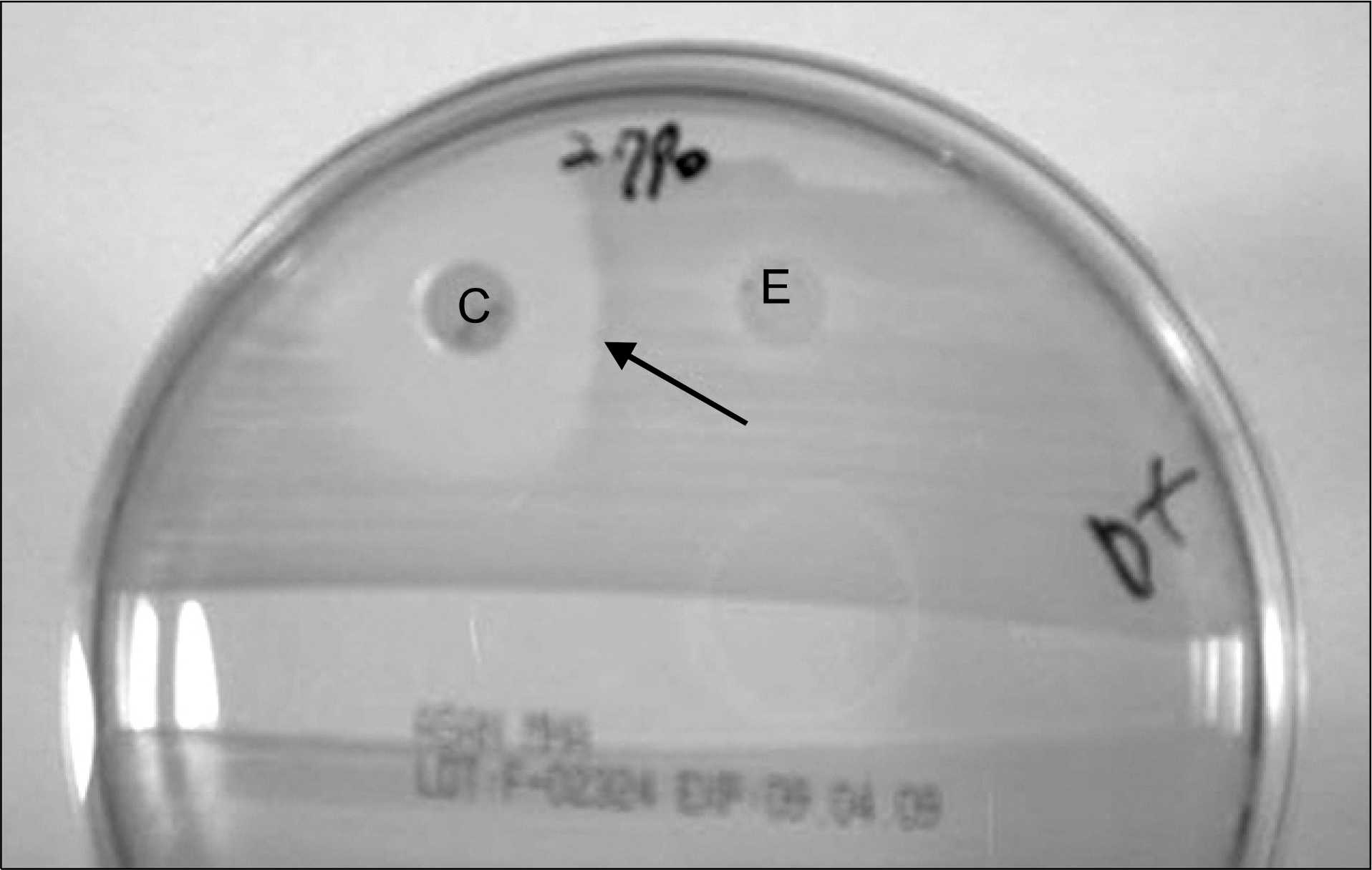Abstract
Background
The Clinical and Laboratory Standards Institute (CLSI) recommends testing for inducible clindamycin resistance in clindamycin non-resistant and erythromycin resistant (CNR-ER) staphylococci by using a D-zone test. Recently, the VITEK2 system was developed to detect inducible clindamycin resistance in staphylococci. We evaluated the performance of the VITEK2 system by comparing it with a D-zone test.
Methods
In detecting inducible clindamycin resistance, a total of 142 clinical isolates of staphylococci were tested by using the VITEK2 Antimicrobial Susceptibility Test (AST)-P601 card (bioMérieux, Marcy l'Etoile, France) and the D-zone test. Of the 142 isolates of staphylococci tested, 114 were CNR-ER staphylococci [40 coagulase-negative staphylococci (CoNS), 74 Staphylococcus aureus] and 28 were staphylococci, either resistant or susceptible to clindamycin and erythromycin (1 CoNS and 27 S. aureus).
Results
Of the 114 CNR-ER staphylococci, 98.6% (73/74) of S. aureus and 32.5% (13/40) of CoNS were inducible clindamycin resistant according to the D-zone test. Overall sensitivity and specificity of the VITEK2 system were 98.8% (85/86) and 98.2% (55/56) respectively, and the agreement between the VITEK2 system and the D-zone test was 98.6% (140/142).
Go to : 
REFERENCES
1. Fiebelkorn KR, Crawford SA, McElmeel ML, Jorgensen JH. Practical disk diffusion method for detection of inducible clindamycin resistance in Staphylococcus aureus and coagulase-negative staphylococci. J Clin Microbiol. 2003; 41:4740–4.
2. Sanchez ML, Flint KK, Jones RN. Occurrence of macrolide-lincosamide-streptogramin resistances among staphylococcal clinical isolates at a university medical center. Is false susceptibility to new macrolides and clindamycin a contemporary clinical and in vitro testing problem? Diagn Microbiol Infect Dis. 1993; 16:205–13.

3. Clinical and Laboratory Standards Institute. Performance standards for antimicrobial susceptibility testing; twentieth informational supplement. Document M100-S20. Wayne, PA; CLSI. 2010.
4. Lee SH, Jang SJ, Moon DS, Park YJ, Ahn GY, Han HL, et al. Evaluation of the detectability of Vitek II system for inducible clindamycin resistance in staphylococci. Korean J Lab Med. 2005; 25:406–10.
5. Lavallée C, Rouleau D, Gaudreau C, Roger M, Tsimiklis C, Locas MC, et al. Performance of an agar dilution method and a Vitek 2 card for detection of inducible clindamycin resistance in Staphylococcus spp. J Clin Microbiol. 2010; 48:1354–7.
6. Uh Y, Hwang GY, Jang IH, Kwon O, Yoon KJ, Kim HY. Distributions of macrolide-lincosamide-streptogramin B resistance phenotypes in clinical isolates of staphylococi. Korean J Clin Microbiol. 2008; 11:78–83.

7. Otsuka T, Zaraket H, Takano T, Saito K, Dohmae S, Higuchi W, et al. Macrolide-lincosamide-streptogramin B resistance phenotypes and genotypes among Staphylococcus aureus clinical isolates in Japan. Clin Microbiol Infect. 2007; 13:325–7.

8. Kim HB, Lee B, Jang HC, Kim SH, Kang CI, Choi YJ, et al. A high frequency of macrolide-lincosamide-streptogramin resistance determinants in Staphylococcus aureus isolated in South Korea. Microb Drug Resist. 2004; 10:248–54.

9. Lim HS, Lee H, Roh KH, Yum JH, Yong D, Lee K, et al. Prevalence of inducible clindamycin resistance in staphylococcal isolates at a Korean tertiary care hospital. Yonsei Med J. 2006; 47:480–4.

10. Cetin ES, Gunes H, Kaya S, Aridogan BC, Demirci M. Macrolide-lincosamide-streptogramin B resistance phenotypes in clinical staphylococcal isolates. Int J Antimicrob Agents. 2008; 31:364–8.

11. Yilmaz G, Aydin K, Iskender S, Caylan R, Koksal I. Detection and prevalence of inducible clindamycin resistance in staphylococci. J Med Microbiol. 2007; 56:342–5.

12. Tang P, Low DE, Atkinson S, Pike K, Ashi-Sulaiman A, Simor A, et al. Investigation of Staphylococcus aureus isolates identified as erythromycin intermediate by the Vitek-1 System: comparison with results obtained with the Vitek-2 and Phoenix systems. J Clin Microbiol. 2003; 41:4823–5.
Go to : 
 | Fig. 1.Inducible clindamycin resistance positivity by the D-zone test. Arrow, blunting of inhibitory zone of clindamycin; C, clindamycin; E, erythromycin. |
Table 1.
Comparison of the D-zone test and the VITEK2 system in detecting of inducible clindamycin resistance in clindamycin susceptible and erythromycin resistant staphylococci isolates (No.=114)
Table 2.
Performance of the VITEK2 system in detecting inducible clindamycin resistance in 142 staphylococci isolates compared to the D-zone test
| VITEK2 ICR test | No. of isolates with D-zone test | |||||
|---|---|---|---|---|---|---|
| S. aureus | CoNS | Total | ||||
| Positive | Negative | Positive | Negative | Positive | Negative | |
| Positive | 72 | 0 | 13 | 1 | 85 | 1 |
| Negative | 1 | 28 | 0 | 27 | 1 | 55 |
Table 3.
Antimicrobial resistance patterns among the 822 staphylococci isolates using the VITEK2 system
Abbreviations: MRSA, methicillin-resistant S. aureus; MSSA, methicillin-susceptible S. aureus; MRCoNS, methicillin-resistant coagulase-negative staphylococci; MSCoNS, methicillin-susceptible coagulase-negative staphylococci; CC, clindamycin; EM, erythromycin; S, susceptible; I, intermediate; R, resistant; ICR, inducible clindamycin resistance.




 PDF
PDF ePub
ePub Citation
Citation Print
Print


 XML Download
XML Download